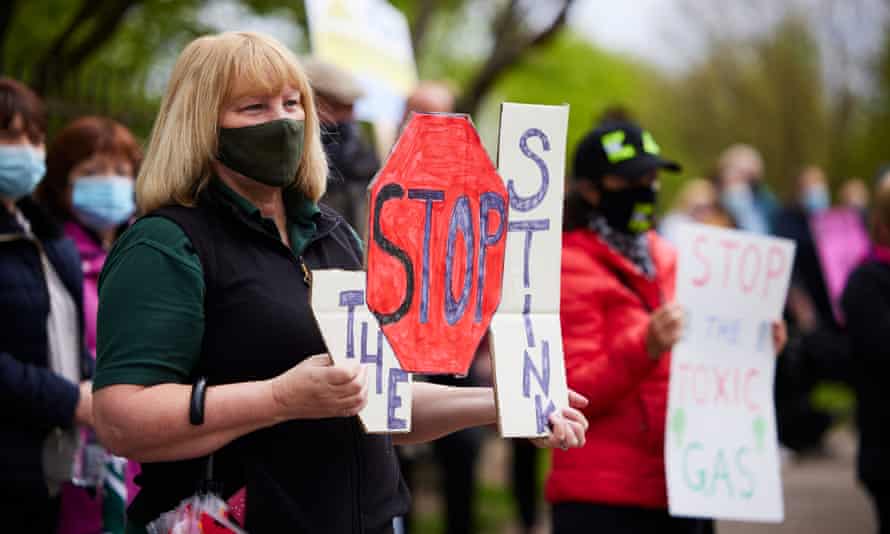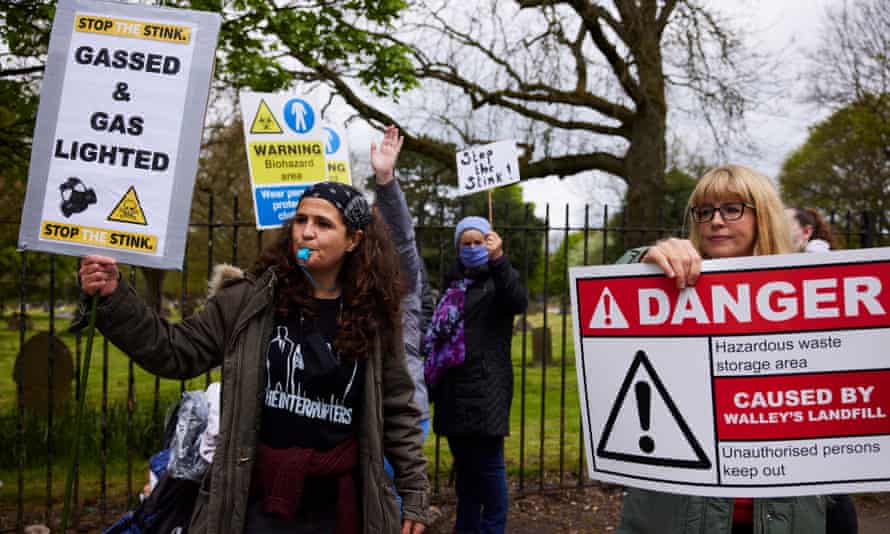‘We feel vindicated’: life by a landfill after vital high court ruling
People living amid toxic fumes hope ruling will force Walleys Quarry to make urgent changes

When she returned to her home in the village of Knutton, outside Newcastle-under-Lyme, after a trip to London on Thursday, the landfill fumes hit Helen Vincent like a brick wall. “We were saying to each other: ‘Oh how nice was the fresh air in London?’ You won’t hear many people say that,” she laughed.
Vincent had been in London for a landmark high court ruling which ordered the Environment Agency to do more to protect five-year-old Mathew Richards from the landfill’s hydrogen sulphide fumes, which doctors said were shortening his life expectancy.
“It feels like the biggest victory just for someone to say yes, we believe you. We’ve been hitting our heads against a wall for so long with this,” said Vincent. “We’re realistic, we know no one’s got a magic wand which is going to make it go away overnight. But now at least we can see some light at the end of the tunnel.”
Walleys Quarry landfill, situated on the edge of the village of Silverdale, has caused issues for years, but it was at the start of 2021 that hydrogen sulphide levels recorded at the site exceeded World Health Organization guidelines.
Hundreds of people in the surrounding area say they have suffered sore throats, itchy eyes, nosebleeds, headaches and sleep deprivation, while schoolchildren have been kept inside at lunchtimes to avoid the fumes.
Sian Rooney lives more than a mile from the landfill but had to use her inhaler more regularly before moving on to an oral tablet for her asthma as her breathing got worse. “It’s frightening for your health to deteriorate without any warning,” she said. “I definitely believe it’s to do with the landfill. When I went to Devon for two weeks, I literally didn’t need any medication, but as soon as I got home, my asthma got worse quite quickly.”

She also fears for her four-year-old son, who coughs more when the fumes are bad. “For a long time I couldn’t sleep at all because I was absolutely terrified of what it was doing to him,” she said.
“When the fumes start coming out, my first thing is to run, turn the air purifier up and put it in his room to stop the fumes getting in.”
A community health survey of 1,881 people in the nearby area, conducted in June, found that 83% had reported physical or mental health effects from the landfill, and 24% had discussed their problems with a GP. A total of 144 people had been prescribed medication as a result.
The survey, submitted to the high court as evidence of the landfill’s wider community impact, contained dozens of distressing accounts from parents of the effects on their children, with many being forced to take time off school.
“My two-year-old is consistently congested, coughing, not eating and sleep deprived,” wrote one, while another said: “My daughter started having nosebleeds out of the blue … she had nine nosebleeds in seven days, she has had to stop doing PE at school. She wakes during the night from coughing and has been having a lot more headaches to the point she cries while holding her head.”
Mental health problems have also soared; the local NHS trust and Mind have recruited a counsellor specifically to deal with problems apparently caused by the landfill.
“Personally, because of sleep deprivation I was referred to mental health services at work,” said Vincent. “But there’s people a lot worse than me.”
Work is ongoing to “cap” parts of the site in order to reduce fumes, but outside the landfill on Friday morning Dr Mick Salt, a radiation physicist who has become a local expert on the landfill emissions, said he was surprised the EA weren’t on site after the ruling.
“The timescale for change is so tight, they should be here today making sure that temporary capping material is going on. The targets in the ruling are actually very harsh,” Salt said. He spends up to 10 hours a week monitoring emissions and holding authorities to account on the issue: “When I see a regulator or a large, multimillion pound company trying to steamroll over a community and dazzle them with science, I just stand in the way.”
The villages around the landfill have some of the highest rates of deprivation in England, which many believe may be part of the reason why the issue has been unaddressed for so long. “This case was really shocking to me, and I don’t think it would have happened in many other parts of the country,” said Rebekah Carrier, the solicitor who represented Mathew at the high court.
For the people living around Silverdale, Thursday’s high court ruling was a huge milestone in their ongoing battle to “stop the stink”. “We do feel vindicated,” said Rooney. “I just hope this ruling finally forces them to act more decisively and urgently.”
A spokesperson from Walleys Quarry said: “We have noted the judgment and will take advice on what it means on a practical operational level, given significant changes have been in progress for some time.
“We will work with the Environment Agency and other local stakeholders to continue our work to mitigate local concerns and update the community as appropriate.”